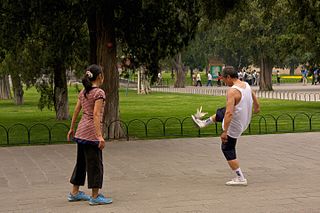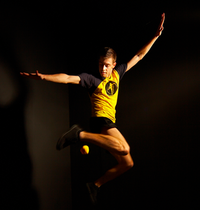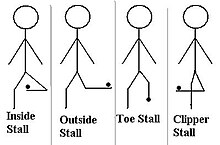
The schottische is a partnered country dance that apparently originated in Bohemia. It was popular in Victorian era ballrooms as a part of the Bohemian folk-dance craze and left its traces in folk music of countries such as Argentina, Finland, France, Italy, Norway ("reinlender"), Portugal and Brazil, Spain, Sweden, Denmark, Mexico, and the United States, among other nations. The schottische is considered by The Oxford Companion to Music to be a kind of slower polka, with continental-European origin.

Flying disc freestyle, also known as freestyle Frisbee in reference to the trademarked brand name, is a sport and performing art characterized by creative, acrobatic, and athletic maneuvers with a flying disc. Freestyle is performed individually or more commonly in groups, both competitively and recreationally.

Jianzi, tī jianzi (踢毽子), tī jian (踢毽), or jianqiú (毽球), is a traditional Chinese sport in which players aim to keep a heavily weighted shuttlecock in the air using their bodies apart from the hands, unlike in similar games such as peteca and indiaca. The primary origin of jianzi is an ancient Chinese game called Cuju, from the Han dynasty, 2,000 years ago. Jianzi is played on a badminton court using inner or outer lines in different competition settings. It can also be played artistically, among a circle of players in a street or park, with the objective to keep the shuttle 'up' and show off skills. In Vietnam, it is known as đá cầu, and it is the national sport. In the Philippines, it is known as sipa and was also the national sport, until it was replaced by arnis in December 2009.
In human biology, footedness is the natural preference of one's left or right foot for various purposes. It is the foot equivalent of handedness. While purposes vary, such as applying the greatest force in a certain foot to complete the action of kick as opposed to stomping, footedness is most commonly associated with the preference of a particular foot in the leading position while engaging in foot- or kicking-related sports, such as association football and kickboxing. A person may thus be left-footed, right-footed or ambipedal.

Freestyle BMX is bicycle motocross stunt riding on BMX bikes. It is an extreme sport descended from BMX racing that consists of five disciplines: street, park, vert, trails, and flatland. In June 2017, the International Olympic Committee announced that freestyle park was to be added as an Olympic event to the 2020 Summer Olympics.

Flatland is a freestyle BMX riding style performed on smooth flat surfaces that do not include any ramps, jumps, or grindrails. It is sometimes described as a form of artistic cycling with a blend of breakdancing.

The front kick in martial arts is a kick executed by lifting the knee straight forward, while keeping the foot and shin either hanging freely or pulled to the hip, and then straightening the leg in front of the practitioner and striking the target area. It is desirable to retract the leg immediately after delivering the kick, to avoid the opponent trying to grapple the leg and to return to stable fighting stance.

In martial arts and tricking, the 540 kick is a jump kick move. It involves a rotation of approximately 540 degrees.
The 360 Crescent kick is a martial arts kick that received its name from the motion of the kick itself. It is also sometimes called, 360 kick, or Jump spin kick. The practitioner jumps into the air and executes a 360 degree turn while keeping his or her body perpendicular to the ground. As soon as the kicker leaves the ground the kicking leg should be extended as straight and high as possible. The kicking leg is normally the same side as the direction that the practitioner is spinning. For example, it will be the right leg if the practitioner is spinning to the right or the left leg if the practitioner is spinning to the left.

The flare is an acrobatic move in which the performer alternates balancing the torso between either arm while swinging the legs beneath in continuous circles. It is a fundamental b-boying/bgirl power move, and in gymnastics it may be performed on a pommel horse or during the floor exercise. The move is commonly spelled flair in gymnastics and further may be called a "Thomas flair" after its originator, Kurt Thomas.

Freestyle football is the art of juggling a football using any part of the body, excluding the elbows to the hands. It combines football tricks, dance, acrobatics and music to entertain onlookers and compete with opponents. The official governing body for this sport is known as the World Freestyle Football Association (WFFA).
A freestyle skateboarding trick is a trick performed with a skateboard while freestyle skateboarding. Some of these tricks are done in a stationary position, unlike many other skateboarding tricks. The keys to a good freestyle contest run are variety, difficulty, fluidity, and creativity. This is an incomplete list, which includes most notable tricks.
This is a general glossary of the terms used in the sport of gymnastics.
3D Aerobatics or 3D flying is a form of flying using flying aircraft to perform specific aerial maneuvers. They are usually performed when the aircraft had been intentionally placed in a stalled position for purposes of entertainment or display. They are also often referred to as post-stall maneuvers, as they occur after aerodynamic stall has occurred and standard control surface deflections, as used in flight, are not effective.

In association football, shooting is hitting the ball in an attempt to score a goal. It is usually done using the feet or head. A shot on target or shot on goal is a shot that enters the goal or would have entered the goal if it had not been blocked by the goalkeeper or another defensive player.

Jump City: Seattle is an American television series that aired on G4 from February 15 to April 5, 2011. It featured four of the top freerunning and parkour teams in the United States participating in a parkour competition. Each week, the athletes competed in different parkour challenges spread out across the streets of Seattle. The series ran for eight episodes and was not renewed for a second season. Team Tempest, led by Levi Meeuwenberg and Brian Orosco of American Ninja Warrior fame, won the competition.

Martin Sladek is multiple world and European freestyle footbag champion. He won the world title in 2009, 2011, 2014-2016. In 2009 he won in 2 disciplines: the main one and Doubles Circle Contest. He won the 1st place in 2008-The most successful athlete in the Special sport performance category and also judges at world footbag championships of footbag. His routines reached the best level of technical merit, artistic impression and cooperation and the performance presented by him at the 2009 world footbag championship in Berlin is the top rated performance in all the three criteria in the history of the sport.

A footbag is a small, round bag usually filled with plastic pellets or sand, which is kicked into the air as part of a competitive game or as a display of dexterity. "Hacky Sack" is the name of a brand of footbag popular in the 1970s, which has since become a generic trademark.

The Strictly is a signature dance routine from the BBC show Strictly Come Dancing, which launched in the 13th series of the popular entertainment show. The dance was devised by Strictly Come Dancing's Director of Choreography, Jason Gilkison and draws inspiration from some of the show's most iconic moves, as well as celebrating some of the show's stars.

















